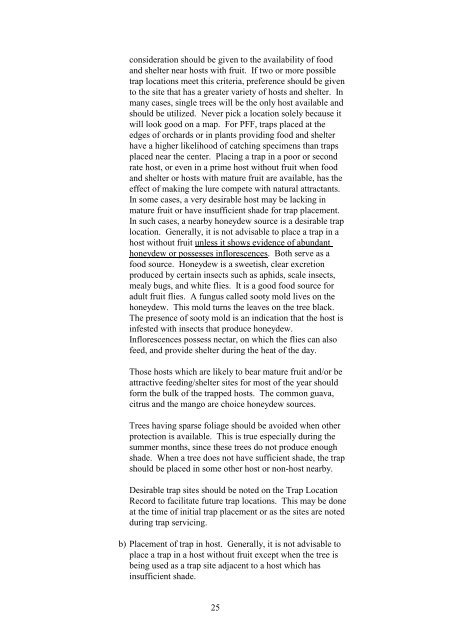Action Plan Peach Fruit Fly Bactrocera zonata - Nuclear Sciences ...
Action Plan Peach Fruit Fly Bactrocera zonata - Nuclear Sciences ...
Action Plan Peach Fruit Fly Bactrocera zonata - Nuclear Sciences ...
You also want an ePaper? Increase the reach of your titles
YUMPU automatically turns print PDFs into web optimized ePapers that Google loves.
consideration should be given to the availability of food<br />
and shelter near hosts with fruit. If two or more possible<br />
trap locations meet this criteria, preference should be given<br />
to the site that has a greater variety of hosts and shelter. In<br />
many cases, single trees will be the only host available and<br />
should be utilized. Never pick a location solely because it<br />
will look good on a map. For PFF, traps placed at the<br />
edges of orchards or in plants providing food and shelter<br />
have a higher likelihood of catching specimens than traps<br />
placed near the center. Placing a trap in a poor or second<br />
rate host, or even in a prime host without fruit when food<br />
and shelter or hosts with mature fruit are available, has the<br />
effect of making the lure compete with natural attractants.<br />
In some cases, a very desirable host may be lacking in<br />
mature fruit or have insufficient shade for trap placement.<br />
In such cases, a nearby honeydew source is a desirable trap<br />
location. Generally, it is not advisable to place a trap in a<br />
host without fruit unless it shows evidence of abundant<br />
honeydew or possesses inflorescences. Both serve as a<br />
food source. Honeydew is a sweetish, clear excretion<br />
produced by certain insects such as aphids, scale insects,<br />
mealy bugs, and white flies. It is a good food source for<br />
adult fruit flies. A fungus called sooty mold lives on the<br />
honeydew. This mold turns the leaves on the tree black.<br />
The presence of sooty mold is an indication that the host is<br />
infested with insects that produce honeydew.<br />
Inflorescences possess nectar, on which the flies can also<br />
feed, and provide shelter during the heat of the day.<br />
Those hosts which are likely to bear mature fruit and/or be<br />
attractive feeding/shelter sites for most of the year should<br />
form the bulk of the trapped hosts. The common guava,<br />
citrus and the mango are choice honeydew sources.<br />
Trees having sparse foliage should be avoided when other<br />
protection is available. This is true especially during the<br />
summer months, since these trees do not produce enough<br />
shade. When a tree does not have sufficient shade, the trap<br />
should be placed in some other host or non-host nearby.<br />
Desirable trap sites should be noted on the Trap Location<br />
Record to facilitate future trap locations. This may be done<br />
at the time of initial trap placement or as the sites are noted<br />
during trap servicing.<br />
b) Placement of trap in host. Generally, it is not advisable to<br />
place a trap in a host without fruit except when the tree is<br />
being used as a trap site adjacent to a host which has<br />
insufficient shade.<br />
25













